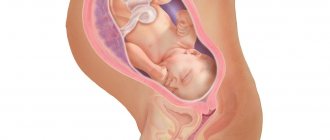Normal discharge that you shouldn't worry about
This is considered a secretion of a light color of a mucous nature, to which viscous threads or crumbly impurities can be attached. Young mothers should not worry if they find this kind of discharge in their newborn girl. Copious mucous discharge is often found in the second week of a baby’s life.
In rare cases, a small amount of blood may be mixed in (as during menstruation). Along with bloody discharge, a newborn girl's nipples may become slightly swollen, and with light pressure, a thick, cloudy liquid (colostrum) may appear.
There is no need to worry, this phenomenon is considered absolutely safe and is called “sexual or hormonal crisis of newborns.” This is quite normal and understandable: this is how the baby’s reproductive system responds to the increased level of the mother’s sex hormones, which enter the child’s body through the placenta or with milk. This condition does not require special treatment. At this time, you just need to pay closer attention to the girl’s hygiene.
Starting from 3-4 weeks of puberty, a period of hormonal “rest” begins. From this time until the age of 7-8, when the prepubertal period begins, mucous discharge in girls almost does not appear.
This stage of puberty is characterized by hormonal changes in the body. With it, under the influence of its own hormones (about 1 year before the onset of the first menstruation), the child again experiences physiological vaginal discharge. At the age of 9-10, and for some at 15 years, discharge in girls intensifies, becomes cyclical, and in adolescents a menstrual cycle is established.
Discharge at 12-13 years old
Good afternoon
Girls in adolescence, from about 12 - 13 - 14 years old, often experience vaginal discharge. During this period, the body begins to prepare for the first menstruation, so the production of hormones increases. Because of this, the so-called pubertal leucorrhoea. The first such secretions occur several months before the first menstruation. White discharge should not cause concern for either the mother or the girl herself, if it is colorless or white, not very abundant, does not have a bad odor and is not accompanied by itching and discomfort in the perineum. After the end of puberty, the mucus or fluid secreted from the vagina of a girl, as well as an adult woman, will be called sexual secretion, vaginal discharge, and this is the norm.
Thus, in a growing girl of 10-12 years old, discharge on her panties may not indicate deviations in the sexual sphere, if their appearance corresponds to the norm. So is a teenager’s body preparing for a major change in work and menarche?
When discharge is not normal
The following symptoms may indicate that a 12-13 year old girl has gynecological problems:
- the appearance of a smell (fishy, sour, curd, etc.);
- unusual color (yellow, greenish, grayish);
- change in texture (for example, foamy or curdled, rich liquid);
- itching, burning, redness of the external genitalia;
- bloody vaginal discharge in girls under 11-12 years of age.
Such discharge (brown - mucous, bloody, yellow with an unpleasant odor) cannot be the norm in girls either at 12 years old, or at 13-14, or at any other age, or accompany the child’s transitional age. As a rule, they are a symptom of colpitis, vulvovaginitis or vaginal dysbiosis. By the way, the absence of sexual intercourse in the past does not exclude the possibility of infection.
Possible causes of “bad” discharge at 12-13 years of age:
- STI
- Vulvovaginitis;
- Herpetic infection;
- Opportunistic pathogens;
- Foreign body in the vagina;
- Worms and intestinal parasites;
- Congenital anomalies of genital development;
- Tumors of the genital organs.
What to do if you have such complaints
You need to go to a gynecologist and get tested, that is, undergo a full examination (PCR, culture), but just a smear is not enough. It is not very informative in this case. The thyroid gland and hormones have nothing to do with it at all. If necessary, we invite you to our center for an appointment with a doctor.
Sincerely, duty doctor-consultant of the clinic.
• How to make an appointment with a pediatric gynecologist
Pathological discharge: causes and associated symptoms
Pathological discharge in newborn girls is often very copious, mixed with blood, pus, and accompanied by a sharp, unpleasant odor. They also often occur during hormonal “rest”, that is, in the period from 1 month to 7-8 years.
Purulent discharge in girls
Purulent discharge in girls most often appears due to inflammatory processes that affect the external genitalia of the child or the vaginal mucosa. The reason for this is the physiological characteristics of the children's vagina and vulva. The fact is that the mucous membrane that lines the vagina in little girls has a loose structure and is very tender.
In addition, their vagina does not have the necessary conditions for the normal existence of lactic acid fermentation rods. In adult women, these rods provide an acidic environment that prevents the proliferation of pathogenic bacteria and fungi.
The child’s vagina has an alkaline environment, and conditionally pathogenic microorganisms are constantly present in it. With a decrease in immunity, non-compliance with hygiene rules, and allergic diseases, these bacteria begin to actively multiply, which causes the appearance of discharge in girls.
Yellow-green discharge in girls
The onset of the inflammatory process is characterized by the appearance of not only pathological yellow or green discharge in girls, but also symptoms such as:
- redness (hyperemia) of the external genitalia and adjacent areas of the skin;
- swelling;
- moderate or severe burning and itching, which sharply intensifies when urinating.
Yellow-green discharge in girls will indicate the presence of bacterial vulvovaginitis (inflammation of the vaginal mucosa).
White discharge in girls
If the balance of vaginal microflora is disturbed, the child will produce grayish or milky creamy leucorrhoea, accompanied by the smell of rotten fish. A frothy discharge will indicate the presence of a trichomonas infection in a little girl.
Watery discharge in girls
With allergic vulvovaginitis, the discharge will be watery, and the mucous membrane will become very thin and dry.
Physiological and pathological discharge in girls
Normal vaginal discharge in girls should not be a cause for concern.
By their number, smell and color, one can judge the presence of inflammation in the genitals, hormonal imbalance or the presence of an infectious disease. Vaginal discharge is the norm not only in adult women and puberty girls. This feature is also inherent in little girls. Immediately after birth, a newborn girl produces physiological leucorrhoea from the genital tract, which is divided into normal (physiological) and pathological (associated with one or another abnormality or disease).
What kind of discharge is normal for girls?
Vaginal discharge is characteristic of the female body of any age and occurs as a result of the normal functioning and cleansing of the organs of the reproductive system. This specific secretion contains:
- epithelial cells;
- mucus secreted by glands located in the vagina and its vestibule;
- lymph;
- leukocytes (blood cells);
- microorganisms of normal vaginal microflora;
- some other components.
The amount and composition of secretions depend on the state of the body and the general hormonal background.
[ads-pc-1]
A secret secreted by the organs of the female reproductive system is considered normal if:
- it is transparent or light;
- is mucous in nature;
- includes stringy threads or impurities of a crumbly consistency;
- does not have a specific, sharp, unpleasant odor.
In some cases, during the neonatal period (in the first few weeks of life), a girl may discharge a bloody, fairly copious secretion from the vagina, similar to menstruation. This is also accompanied by swelling of the nipples and the release of colostrum from them. This is a completely normal phenomenon associated with the entry of too many maternal hormones into the newborn’s body: first through the placenta, and then with mother’s milk. This condition goes away on its own and does not require any treatment.
Approximately a month after birth, a period called “neutral” begins in the girl’s development. It lasts until about 7-8 years, and is characterized by hormonal “rest”, and the girl has practically no physiological discharge from the vagina. Upon reaching prepubertal age, the activity of the gonads is activated, and the secretion of vaginal discharge becomes more active, right up to the first menstruation. Then the discharge becomes cyclical.
Causes of discharge in girls
Pathological discharge from the genital opening in girls can occur due to infection with various types of infections , which are activated for the following reasons:
- suppression of local and general immunity by respiratory and other diseases of a bacterial and viral nature;
- improper and insufficiently frequent genital hygiene;
- urinary tract diseases;
- hormonal imbalance in the body;
- diabetes mellitus (can provoke fungal vulvovaginitis);
- transfer of infectious agents from the rectum to the vagina and vulva;
- hypothermia;
- helminthic infestation;
- antibiotic treatment;
- mechanical damage to the walls of the vagina and vulva.
Little girls do not have lactic acid bacteria in their vaginas, which are characteristic of the microflora of adult women. These microorganisms are one of the steps in protecting women’s health, therefore, in their absence, infections develop especially quickly. In this regard, the introduction of pathological agents into the genital organs very often ends in vulvovaginitis in girls, accompanied by abnormal discharge.
Symptoms accompanying discharge in girls
Non-physiological discharge from the genital tract in little girls is most often accompanied by the following symptoms:
- itching, redness of the vulva, burning;
- the discharge has an unpleasant (fishy) odor, this may indicate bacterial vaginosis;
- discharge becomes yellowish or greenish when infected with Trichomonas;
- vaginal candidiasis (thrush) - characterized by curdled white discharge from the vagina;
- Blisters, redness and sores may be present on the external genitalia, which indicates the presence of infection with the herpes virus.
In addition, when suffering from cystitis and other diseases of the genitourinary system, a girl may experience frequent urge to urinate and pain in the lower abdomen. In particularly advanced cases, the body temperature rises. Urination becomes painful.
[ads-pc-2]
Diagnosis of pathological discharge
A pediatric gynecologist diagnoses diseases associated with pathological vaginal discharge in girls. After contacting this specialist, a number of examinations and tests are prescribed:
- general tests - blood and urine;
- culture (smear) from the vagina to identify bacterial agents that provoked inflammation;
- stool analysis to determine intestinal dysbiosis and the presence of worm eggs;
- examination of the genital tract for the presence of a foreign body;
- blood test for hormones;
- polymerase chain reaction (PCR), which allows you to identify the type of pathogen (mycoplasma, ureaplasma, chlamydia), as well as determine whether antibodies to these agents are present in the child’s blood.
Treatment of vaginal discharge
Treatment directly depends on the results of the child’s examination. There are such options:
- if necessary, foreign objects that irritate the mucous membrane of the vulva or vagina are removed;
- After determining the type of infectious agent, local and general drug therapy is carried out. In each case, an individual approach to treating the patient is used, taking into account all the features of the course of the disease, medical history, chronic ailments and the girl’s age. For treatment, antibacterial, antifungal, antiviral drugs may be prescribed, as well as drugs that relieve inflammation and normalize the vaginal microflora;
- if a helminthic infestation is detected, in addition to the child, all family members are also treated to prevent relapses;
- hormonal therapy for hormonal imbalance;
- All foods that can provoke an allergic reaction are excluded from the girl’s diet;
- Local treatment is prescribed, consisting of baths, washing with antiseptic solutions, and decoctions of medicinal herbs. Therapy may also be prescribed in the form of ointments or creams;
- The key to a speedy recovery is regular change of underwear and bed linen;
- the acute stage of the disease may require bed rest;
- if the discharge is caused by diseases of the excretory (urinary) system, appropriate treatment is carried out, more often with the use of antibiotics. In addition, a special drinking regime is required: the patient drinks at least 2 liters of liquid per day, including fruit drinks and decoctions that have antiseptic properties.
[ads-pc-3]
Prevention of discharge in girls
To avoid the appearance of pathological discharge from the genital fissure in a girl, it is necessary to adhere to the rules of prevention:
- Proper intimate hygiene. You need to wash your genitals after each bowel movement; make sure that movements are made only from front to back, that is, from the vagina to the anus. This will prevent bacteria from entering the genital tract from the rectum. It is not advisable to carry out water procedures using soap. You should wash only the areas of the genital organs that are visible to the eye and do not try to go deeper with your fingers. It is also not recommended to use washcloths and sponges for hygiene of little girls, as this can damage delicate thin skin.
Older girls should wash their genitals every morning and evening.
- Very little girls need to change their diaper as often as possible. Arrange “ventilation” of the genitals, that is, leave the child naked several times a day.
- After washing, you need to use a soft, clean towel or diaper. The movements should not be rough, but only blotting.
- Underwear must be changed daily, after the morning toilet. Panties should be made from natural fabrics and should not compress or drag on the body.
- Treatment of chronic diseases of the genitourinary system.
- Regular testing to monitor your health.
When is treatment needed?
Treatment for a child can only be prescribed by a doctor. In this case, an individual approach should be taken, taking into account the girl’s age and the presence of any chronic diseases.
First of all, the doctor must determine the causative agent of vulvovaginitis and how sensitive it is to antibiotics. Next, drug treatment using antifungal, antiviral drugs and antibiotics is indicated.
In acute cases of the disease and heavy discharge in girls, strict bed rest is necessary.
If it is discovered that the cause of the girl’s discharge is a helminthic infection, treatment should also be carried out by the baby’s parents. At the same time, along with drug therapy, it is recommended to wash the baby with herbal infusions or antiseptic solutions.
As a preventative measure, the child should:
- lead a correct, healthy lifestyle;
- do not contact with bacterial and viral carriers;
- observe the rules of personal hygiene;
- Treat any infectious diseases as soon as possible.
So, if you notice pathological discharge in your daughter, try to consult a doctor as soon as possible to exclude complications and shorten the treatment time. After all, as you know, it is much easier to cope with a disease at an early stage than in an advanced form.
Will leucorrhoea go away after my period?
Not necessary. Most likely not, because when your period begins, leucorrhoea either simply appears if you didn’t have it before, or if you had it, then it becomes more balanced, that is, if leucorrhoea is a vaginal discharge, it becomes more susceptible to the cycle, then there are not the same ones all month, but at first thin, then thicker, and at the moment of ovulation they can generally turn into such a specific plug, I think the girls noticed such a clot of discharge on the day of ovulation, then they again become more liquid and so on.
What it is?
The sexual crisis frightens parents because the discharge in newborn girls is bloody, which in the eyes of parents, especially young ones, is an undoubted pathology. And they start to panic.
As pediatricians say, discharge in newborn girls is quite normal. Thus, the child’s body starts the cleansing process, adapting to life in an environment that is new to it. The thing is that before childbirth, the mother’s body accumulates estrogens - these hormones are necessary to activate the birth process. Accordingly, the child’s body receives them, and in excess. But while the child is in the intrauterine state, this is the norm for him.
But after childbirth, communication with the mother ceases. Accordingly, the supply of these hormones to the child’s body stops. But they are still unnatural for him, so he begins to cleanse himself of them. It begins on the third or fourth day of life and lasts an average of 2 weeks. But sometimes the process takes up to 6-8 weeks.
Discharge in girls in infancy: when to see a doctor
The sexual crisis in girls in infancy lasts a maximum of 8 weeks, after which it stops on its own. But, in a situation where the discharge has not stopped during this period, and the following symptoms are observed during the first three days, it is necessary to consult a doctor:
- The child demonstrates that urination is painful for him, he begins to cry either before it starts or during it, this can be understood during night urination, when with each urination the child whines or screams, by the intensity of the crying you can understand how painful it is for the baby;
- The discharge has an unpleasant odor, elements of pus, or a greenish tint;
- The discharge is copious;
- The color of the urine has changed, there is bloody residue or greenish mucus in it;
- Inflammation of the external genital organs, redness and rash are observed.
In this case, it is necessary to examine the child, as well as obtain advice on the choice of care products and hygiene methods, as well as medications, if necessary.










